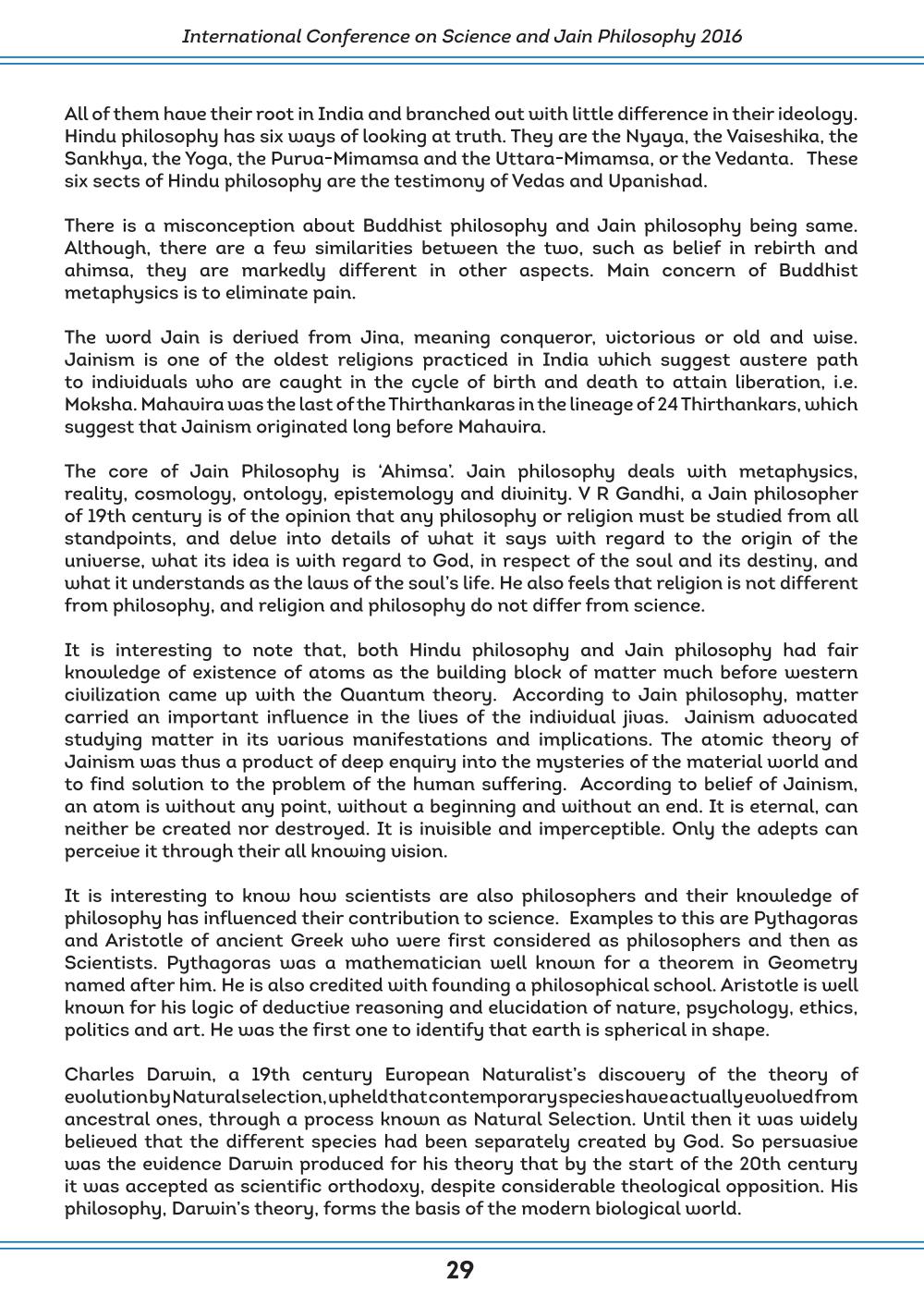________________
International Conference on Science and Jain Philosophy 2016
All of them have their root in India and branched out with little difference in their ideology. Hindu philosophy has six ways of looking at truth. They are the Nyaya, the Vaiseshika, the Sankhya, the Yoga, the Purua-Mimamsa and the Uttara-Mimamsa, or the Vedanta. These six sects of Hindu philosophy are the testimony of Vedas and Upanishad.
There is a misconception about Buddhist philosophy and Jain philosophy being same. Although, there are a few similarities between the two, such as belief in rebirth and ahimsa, they are markedly different in other aspects. Main concern of Buddhist metaphysics is to eliminate pain.
The word Jain is derived from Jina, meaning conqueror, victorious or old and wise. Jainism is one of the oldest religions practiced in India which suggest austere path to individuals who are caught in the cycle of birth and death to attain liberation, i.e. Moksha. Mahavira was the last of the Thirthankaras in the lineage of 24 Thirthankars, which suggest that Jainism originated long before Mahavira.
The core of Jain Philosophy is 'Ahimsa. Jain philosophy deals with metaphysics, reality, cosmology, ontology, epistemology and divinity. VR Gandhi, a Jain philosopher of 19th century is of the opinion that any philosophy or religion must be studied from all standpoints, and delve into details of what it says with regard to the origin of the universe, what its idea is with regard to God, in respect of the soul and its destiny, and what it understands as the laws of the soul's life. He also feels that religion is not different from philosophy, and religion and philosophy do not differ from science.
It is interesting to note that, both Hindu philosophy and Jain philosophy had fair knowledge of existence of atoms as the building block of matter much before western civilization came up with the Quantum theory. According to Jain philosophy, matter carried an important influence in the lives of the individual jiuas. Jainism aduocated studying matter in its various manifestations and implications. The atomic theory of Jainism was thus a product of deep enquiry into the mysteries of the material world and to find solution to the problem of the human suffering. According to belief of Jainism, an atom is without any point, without a beginning and without an end. It is eternal, can neither be created nor destroyed. It is invisible and imperceptible. Only the adepts can perceive it through their all knowing vision.
It is interesting to know how scientists are also philosophers and their knowledge of philosophy has influenced their contribution to science. Examples to this are Pythagoras and Aristotle of ancient Greek who were first considered as philosophers and then as Scientists. Pythagoras was a mathematician well known for a theorem in Geometry named after him. He is also credited with founding a philosophical school. Aristotle is well known for his logic of deductive reasoning and elucidation of nature, psychology, ethics, politics and art. He was the first one to identify that earth is spherical in shape.
Charles Darwin, a 19th century European Naturalist's discovery of the theory of evolutionby Natural selection, upheld thatcontemporary specieshaveactually evolved from ancestral ones, through a process known as Natural Selection. Until then it was widely believed that the different species had been separately created by God. So persuasive was the evidence Darwin produced for his theory that by the start of the 20th century it was accepted as scientific orthodoxy, despite considerable theological opposition. His philosophy, Darwin's theory, forms the basis of the modern biological world.
29




